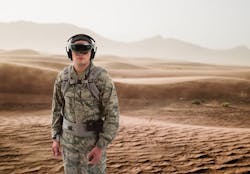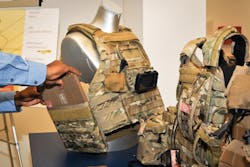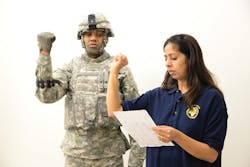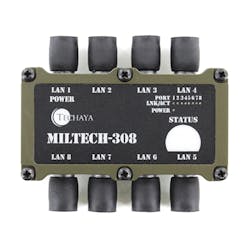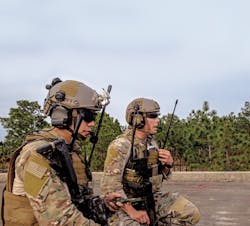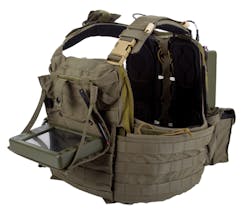Reliable power, information overload, size and weight, and interpreting old-fashioned infantry hand signals top research priorities for digitizing the warfighter.
By J.R. Wilson
The first recorded war took place between Sumer and Elam in Mesopotamia in 2700 BC, but archaeological evidence shows a history of violent mass conflict for more than 12,000 years, about the time humans began changing from hunter-gatherers to farmers and builders.
For that entire history, the brunt of war has fallen on the foot soldier, with little change in the basics of individual ground combat other than personal weapons, organization, and training. For all but the last few decades, these warriors generally were the least educated, most disposable members of society - sometimes dismissed as "cannon fodder".
That began to change with the U.S. military in the 20th Century, with the development of a cadre of well-trained noncommissioned officers providing leadership in the moment-to-moment actions on the battlefield. Little else changed, however, until the 21st Century, when infantry began receiving individual communications, navigation-and-location equipment, computing capability, sensors, personal armor, and precision-guided munitions.
These were the result of explosive advances in technology, especially miniaturization and faster, more powerful computing. As a result, the American warfighter in 2015 bears little resemblance to those of 2001 - and far less to any previous generation. Yet despite these advances, little really has changed in how top commanders use the foot soldier in battle.
That is about to change - indeed, already is changing - building on what was done in the past 15 years in the evolution of warfare. Still, this new level could be considered more revolutionary than evolutionary as the next 20 years brings about more change in warfare - and especially in the equipping, capabilities, and use of dismounted infantry - than in the preceding 12,000 years.
That change will be based on wearable electronic devices - sometimes known as wearable devices.
"Wearable computing is part of ubiquitous or pervasive computing," explains Stephen Russell, branch chief of battlefield information processing at the U.S. Army Research Laboratory in Adelphi, Md. Wearable electronics, he says, describes the common availability of computer equipment and sensors that provide information about the environment, the soldier's medical state, and similar information of value to infantry warfighters and commanders.
The prospect of many infantry warfighters with wearable electronics, however, presents a challenge that involves huge volumes of data that somehow must be processed quickly enough to benefit a fast-maneuvering ground fighting force. "Some of the challenges are being able to understand that volume of information and make it available not only to [the individual] soldiers but to command and control in ways that make sense while tailoring it to improve decision-making," Russell says.
"Imagine a soldier on the battlefield communicating with other soldiers - some non-verbal, some passive - and outfitted with a completely instrumented system, such as an arm band that collects and sends medical data," Russell continues. "How do we deal with all that information available not only about the soldier but also his environment and equipment, all of which will be operating interactively?"
Influences on the battlespace
To date, with a few comparatively minor exceptions, wearable computing and electronics for frontline warfighters have been limited to military forecasters, theoreticians, and future tech-development engineers. Problems involve limitations in sufficient capability and broadcast range, and in the size, weight, and longevity of batteries the soldier must wear.
The military is asking for a great deal from future tech, acknowledges Chris Boger, group leader for system integration at the Charles Stark Draper Laboratory in Cambridge, Mass. "The state-of-the-art, specifically with respect to frontline warfighters, really is pretty limited," Boger says. "Most wearable devices are more likely found in training environments or development centers. So the warfighter probably is behind what you would see on a normal consumer at this point. We need to consider the overall system in which the soldier is a part and how the equipment will react to a given environment or activity and interact with other equipment. We have to develop an integrated solution that puts it all together for the best result and stop hanging things on the soldier like a Christmas tree."
Such an approach may be easier said than done, since the infantry warfighter's needs are so broad. What the military is asking for "really runs the gamut, from real-time force health status to different means of human augmentation, from exoskeletons to robotics, physiological monitoring, position and navigation, and vibration monitoring," Boger says. "We're also starting to see requests for more system-level answers, and we're trying to break into the brain. How do we monitor cognitive activity."
The challenges of antennas
Some Army researchers are starting to work on a wearables area that has been overlooked for far too long if the concept is ever to succeed: antennas.
"Antennas tend to be the last thought about part of the system. They can be expensive, but when dealing with a mobile or body-wearable antenna, they're not the big expense item in the system," says Mitchell Mayer, a radio electronics engineer at the Army Communications-Electronics Research, Development and Engineering Center (CERDEC) at Aberdeen Proving Ground, Md.
"Usually they develop a new technology, then see what antenna they have on the shelf they can use with it," says Mayer, a retired Army lieutenant colonel now working in the radio-frequency communications division of CERDEC's space and terrestrial communications directorate.
Systems integrators developing wearable radios and helmet- and uniform-mounted sensors usually take the antennas that manufacturers give them; they can't always afford to develop new antennas custom-designed for the application.
"When you look at all the sophisticated systems we have out there, you see soldiers operating it with antennas that have been around for 50 years, such as an 8-foot collapsible stick or a 3-foot metal whip, that are the only approved antennas operating in that frequency by the Army for VHF," Mayer notes. "If they are concerned about visibility to the enemy or operating in a dense forest or jungle, they will collapse the antenna or try some other means to get around it and that limits the range and quality of their communications."
There are different types of wearable antennas - including fabric that uses conductive threads - but so far they don't work very well, and definitely not in the frequencies of U.S. military communications systems like the single-channel ground and airborne radio system (SINCGARS).
Fabric-worn antennas are "a nice experimental thing, but not practical for the Army," Mayer says. "Even if you could put an antenna into the fabric of a uniform, you still would need a connector to the radio, which can be bulky. And any time you make a conductive fabric or something else on the uniform, it has to be laundered - and that is a considerable concern."
Making the antenna part of a warfighter's uniform, moreover, can complicate efforts to relocate the antenna for best reception, or to increase its range, such as on a hilltop or in a tree, Mayer explains.
To overcome some of these problems, researchers are considering RF repeaters mounted on unmanned aerial vehicles (UAVs). "One of the things we are looking at is the ability for expeditionary forces to operate and that means longer ranges," Mayer says. His team has developed a communications relay that fits on an RQ-7 Shadow UAV, which improves the range by about five-fold compared to the existing Shadow antenna.
CERDEC engineers are trying to design wearable antennas based on the antennas' RF transmit and receive propagation patterns - or how much RF energy gets transmitted, how much is reflected back. Unfortunately this approach has its drawbacks. "The problem is when you design an antenna that way and put it in close proximity to the human body, the results you get are sometimes bizarre," Mayer says. "Patterns don't look the way they should because the body absorbs a lot of radiation and blocks some of the rest."
Using his own military experience and speaking with soldiers in the field, Mayer identified what frontline warfighters need most. "In a squad, there is a certain distance between soldiers and they want to communicate while in a prone position. So I designed an antenna to deal with that and told the manufacturer I was more interested in operational, rather than technical, performance."
Problem solved
The effort took some doing, but ultimately found a solution. "We went through a number of false starts doing this, but ultimately came up with a single-channel unit that met the RFI for SINCGARS," Mayer says. That was a start, but created problems of its own. "The radios we use - the Harris PRC-152 and Thales PRC-148, which are the two largest fieldings right now - are software-defined radios, so they are more than just SINCGARS and can operate in other bands up to 540 MHz," he says.
The problem is that wearable antennas can be confining - not only to the warfighter's comfort in the field, but also to the RF com- munications bandwidth the war- fighter can use. "There are no multi-band wearable antennas, so a soldier needing to interface with multiple units has to take multiple antennas to handle each of those," Mayer says.
Solving that challenge may be possible, but it's taking a long time. "An advantage would be a single multi-channel antenna," Mayer says. "I've already issued a new contract solicitation, with two contracts awarded, but that is a three-year effort. There is a second requirement that it also must function if remoted into a tree. The requirement when on the body still must meet the range requirement between two soldiers in a prone position, with that range higher when remoted."
As with the wearable devices themselves, the future of wearable antennas depends on the super-miniaturization of circuitry and a mixture of filters, shielding, and other components. "There are a lot of buzzwords out there such as metamaterials and nanotech that sound good, but the problem is they are not very effective in low frequencies and those that do are extremely expensive," Mayer points out.
Attaching the antenna to the uniform - rather than sewing it in - always is an option. "Today's uniforms use a lot of Velcro and some of these wearable technologies could be Velcroed onto the uniform, which would allow you to change the antenna patch for different uses," Mayer says. "In the future, we may use something like Bluetooth, so you don't have to use a lot of wires. CERDEC's Command, Power and Integration Directorate also is doing a lot of work on batteries, such as miniaturization and capturing the body's kinetic energy."
The safety of the individual warfighter also is a concern, as antennas radiate a radio's RF energy. Depending on the power output and where the antenna sits on the body, it could generate potentially dangerous levels of RF radiation. To that end, CERDEC's Specific Absorption Rate Testing Lab is working with the IEEE standard to test any new antenna design.
"Wearable electronics will be on a battlefield that looks vastly different from today, so the needs of the warfighters also will be different," says Zak Sucher, business development manager at Techaya in Pardes Hana, Israel. "Within 10 years, it all will look different. Bandwidth will grow - both availability and requirements - because you have more and more devices transmitting information in that battlespace. The general direction is higher speed, lower weight, new protocols, and integrating different devices into a single device."
Leveraging COTS
Commercial off-the-shelf (COTS) electronics undoubtedly will play a big role in the future of military wearable electronics, but the way forward isn't always clear. "We've been looking at next-generation systems that leverage commercial developments, but extend and apply these specifically to warfighter concepts of operations," says Jana Schwartz, an information and cognitions engineer in Draper Lab's software & algorithms directorate.
The military environment is far more demanding - and potentially deadly - than the commercial environment, and presents challenges that designers can't ignore. "There are current defense programs that leverage today's COTS technologies, but whether it's military systems or broader applications, wearables tend to rely on you to look at them," Schwartz says. "Your watch may tap to tell you someone is calling, but you still have to look at it. The problem with that in combat is if you are looking at your wrist, you're not looking around. Some technologies have tried to solve that, but are still very new and struggling."
Future wars won't be fought by infantry staring at tiny screens. "They must be able to fight without having eyes on a screen all the time," agrees Techaya's Sucher. "The programs are looking for the right balance to provide information, but be self-activated."
Information overload
Another concern, already manifesting, is information overload. "We're at the point, outside the military, where wearables already have outpaced our ability to deal with all the information they can provide," says Draper Lab's Boger. "For the military, we need to get ahead of that curve so we do more good than harm. That means developing algorithms and systems that can process and store data and determine how and to whom to distribute that information and present it to the user in the best way possible."
The trick is to give warfighters exactly the information they need, when they need it - no more, and no less. "Just as we are able to make better decisions about what route to take by leveraging real-time data in civilian life, the same future applies to warfighters," points out Draper Lab's Schwartz.
"We aren't going to drown them with data, just give them the insights and info they need to be more effective and safer. So it is a transition from a radio station with traffic tracking and weather to Google maps only interrupting me when there is something I should see on the battlefield," Schwartz says. "We will ride on the commercial world's shoulders for a ways, but the stresses and uses in military life are very different and we will have to surpass what a commercial vendor might be interested in developing."
Researchers are starting to consider using a wider variety of the warfighter's senses than viewing text, images, and video on a screen. "The way our brains have evolved, we're not just visual creatures but take in data from all our senses," Schwartz says. "Our brains react differently to seeing something, hearing something, or seeing and hearing at the same time. We need to duplicate that for our warfighters on the battlefield so they can make good decisions as quickly as possible."
Perhaps researchers should take a fresh look at how people absorb complex information quickly, Schwartz suggests. "Presenting data in as intuitive a manner as we can is the path to accomplishing that. There is more recognition of aligning to the user so it is not rejected by the warfighter because it is more distracting than helpful."
Digitizing hand signals
A major effort at the Army Research Lab involves reconciling the silent infantry hand signals with digital technologies like wearable computers and software-defined radio (SDR). Army researchers are trying to move the hand signals that warfighters have used for centuries to convey information and orders without speaking into a digital electronic environment.
Researchers addressed this issue in a "Wearables Notification via Dissemination Service in a Pervasive Computing Environment" study based on the NATO signals developed for silent communications among warfighters who do not speak a common language.
"We conducted an experiment with arm bands on individuals and had them execute several NATO gestures, then ran an experiment to see how we could classify those signals into an accurate determination of their meaning," explains the Army Research Lab's Russell.
"We got as high as 80 to 90 percent accuracy in many cases," Russell continues. "We looked at personalized models, customized to the individual, such as commercial speech-to-text software you have to train to understand your voice, but you need a generalized model, such as Siri. We got a high degree of accuracy with our personalized model and now are extending that to a generalized model."
That same area of research also is leading to one of the most dramatic changes that will be seen on battlefields 10 or 20 years into the future - robotic warfighters that work alongside and communicate with actively pursuing autonomous systems and human/machine interfaces for the future battlespace.
Robotic warfighters
To accomplish it requires 100 percent accuracy and precision in recognizing signaling and communications like the Army Research Lab has been developing.
"Twenty years from now, not all combatants will be human, so without ears or sight, how do we take a wearable signal by a human warfighter and translate that into an appropriate action, for both human and robotic squad members?" Russell asks. "We're researching the fundamental issues, with that as our goal. One element is precision and accuracy, which is what we're working today for human warfighters. A humanoid robot will have arms and legs and could signal to other humans, but not all robots will be humanoid."
Russell says he advocates the expansion of intelligent systems for infantry warfighters. "We're also monitoring a human warfighter's medical state so we can detect not only his message but also if he is dehydrated. A robot - humanoid or otherwise - could receive that message and take water to the human soldier. We are leveraging and integrating our work to couple with what is being done by those building robots and intelligent automations with which we will integrate."
The future goes beyond human warfighters with wearable devices, agrees Draper Lab's Schwartz. "I can imagine a future where robots can do a lot of the things people do today. In that future, we will have to make a moral determination about having them on the battlefield. In the short term, the best way to combine human and machine intelligence is not to rely solely on either human or robot, but let automation and data fusion and our brains work together to get to the right course of action."
Military leaders and technology developers are hesitant to integrate robots into the fighting force in a big way because machines are not very innovative and don't understand when context changes. "Those are the sort of special functions at which humans excel," Schwartz says.
Whether looking at the short-term efforts being pursued by CERDEC, Draper Lab, and Techaya or the far long-term developments central to Army research, it is clear the foot soldier is becoming a platform for sensors and weapons unlike anything ever seen in 12,000 years of warfare.
"The battlefield is changing and we have to be ready for it. As it once was who has the better aircraft or tank, now it is who has the better soldier, more adaptable, better protected," says Techaya's Sucher. "This is a reality and the reason for moving forward is to increase the ability and efficiency of the soldier to identify and eliminate the target faster."
